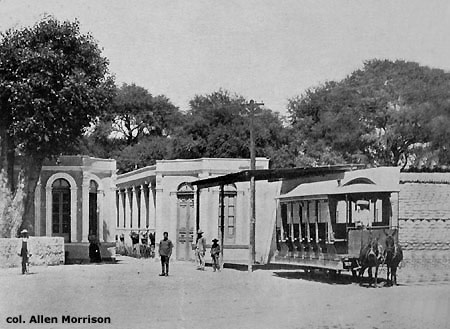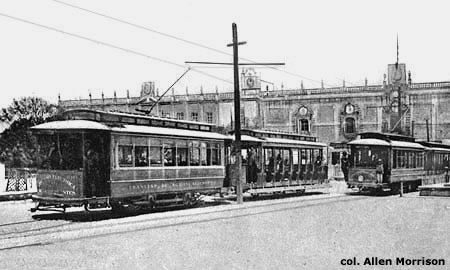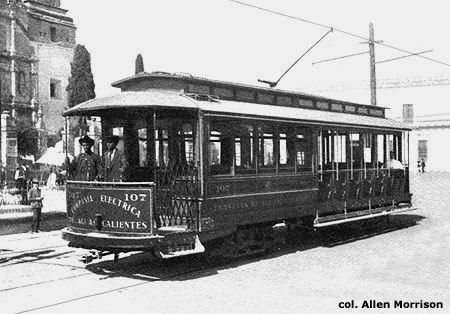The Tramways of
Aguascalientes
BY
Allen Morrison
[set monitor at 640x480 or 800x600 dpi]
Aguascalientes (Hot Waters) was named for its famous spas. The capital of Aguascalientes state, one of Mexico's smallest, is 585 km northwest of Mexico City, on the Mexican Central Railway main line to Ciudad Juárez. Its population was 26,000 in 1900, is about a million today.
Aguascalientes planned a tramway in 1879 - not to connect the railroad station to the town - there was no railroad station - but to take residents to the mineral baths. A horsecar line finally opened in February 1883, ten months before the arrival of the railroad. (Through rail service to Mexico City began in March 1884.) The photograph archives of the John Stephenson Company of New York indicate that Aguascalientes was a customer. The picture below shows a streetcar at the entrance to the Baños de Ojo Caliente (Hot Eye Baths) east of town [see map] [Album Gráfico de México, Mexico City, 1910, p. 379]:

In March 1903 two Americans, John Douglas and John Overton, founded the Compañía Eléctrica de Aguascalientes and ordered an assortment of open and closed electric trams from the American Car Company (a subsidiary of J. G. Brill) in St. Louis, USA. The electric streetcar system which opened on 5 May 1904 was one of the first in Mexico - preceded only by lines in Nuevo Laredo, Mexico City, Torreón and Ciudad Juárez. Track gauge was 1435 mm. The postcard below, mailed in 1909, shows the Plaza Principal [see map] [col. AM]:

Early car orders included several 4-wheel "Metropolitan" type vehicles, closed on one end and open on the other. In 1907 CEA ordered two 8-wheel cars of this type from J. G. Brill. Double-truck cars were unusual on small systems. Here is a picture of double-truck number 107 [Brill's Magazine, Philadelphia, 3/1908, p. 63]:

Electric lines connected the Plaza Principal, the railroad station and the foundry ("FUNDICIÓN") of the American Smelting & Refining Company [see map]. It is not known if the horsecar route to Ojo Caliente was electrified, nor in what ways the Aguascalientes tramway might have changed during the 1910s and 1920s. The Mexican Estadística de Ferrocarriles de Jurisdicción Federal says that the Compañía Productora y Abastecedora de Potencia Eléctrica de Aguascalientes operated 11 electric passenger tramcars and 6 passenger trailers on 18 km of track in 1923. The system closed in 1931. A plan for a "light rail" (modern tramway) line was announced in 2001, but has not developed.
There were industrial railways of various kinds, but no other urban railways in Aguascalientes state.
BIBLIOGRAPHY (in order of publication)
(Though all the trams that ran in Aguascalientes were built by J. G. Brill or its subsidiaries in the United States, U.S. transport journals reported very little about that city, so most of the information on this webpage came from other sources. In addition to the documents listed below, the author is indebted to Harold E. Cox for invaluable data on tramcar orders.)
"Metropolitan Type of Car for Aguascalientes, Mexico" in Brill's Magazine (Philadelphia), December 1907, pp. 241-243. Two pictures of the 4-wheel model.
"Cars and Railway System of Aguascalientes, Mexico" in Brill's Magazine (Philadelphia), March 1908, pp. 62-64. Photo of 8-wheel Metropolitan model and brief route description.
"Aguascalientes: Tranvías Eléctricos" in Album de la Paz y el Trabajo. Mexico City, 1910. A nice description of the electric tramway and three illustrations. This publication is in the Archivo Histórico "Juan Agustín de Espinoza, S.J." at the Universidad Iberoamericana in Torreón. The article was copied and sent by its archivist, Sergio Antonio Corona Páez.
Plano de la Ciudad de Aguas Calientes. (Anonymous), 1918. Large-scale map shows tram lines in detail. This map was contributed by Stanley F. Worris and Russell Powers.
Great Britain. Naval Intelligence Division. A Handbook of Mexico. London, 1919 and 1920 (identical editions). Map in the sleeve in the back of this book shows a rather different tram system from the 1918 map above.
Jesús Gómez Serrano, Aguascalientes en la Historia, 1786-1920. Aguascalientes, 1988. "Los Tranvías" in vol. II, pp. 364-377, concentrates on the construction of the animal system.
Archivo General Municipal, Catálogo Temático, 1882-1932, Aguascalientes, 1996. The "Tranvías" section on pp. 358-363 of vol. 5 lists old contracts and government rulings and shows a picture of a horsecar.
return to
INTRODUCTION & INDEX MAP
Copyright © 2003 Allen Morrison - ALL RIGHTS RESERVED
|


